八年级上>Module 12 Help>Unit 1 What should we do before help arrives?课件
文档属性
| 名称 | 八年级上>Module 12 Help>Unit 1 What should we do before help arrives?课件 | 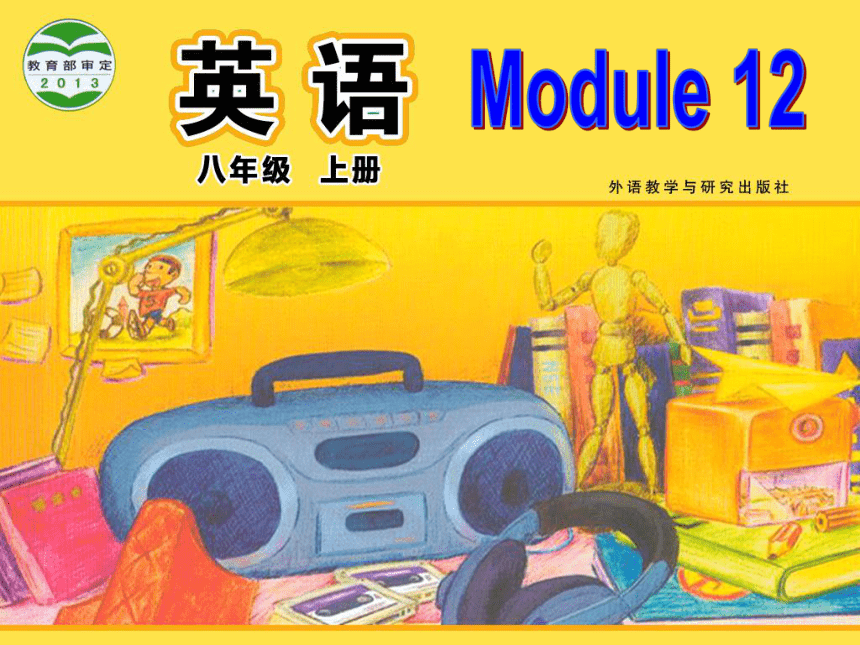 | |
| 格式 | zip | ||
| 文件大小 | 2.1MB | ||
| 资源类型 | 教案 | ||
| 版本资源 | 外研版 | ||
| 科目 | 英语 | ||
| 更新时间 | 2013-12-22 17:04:08 | ||
图片预览

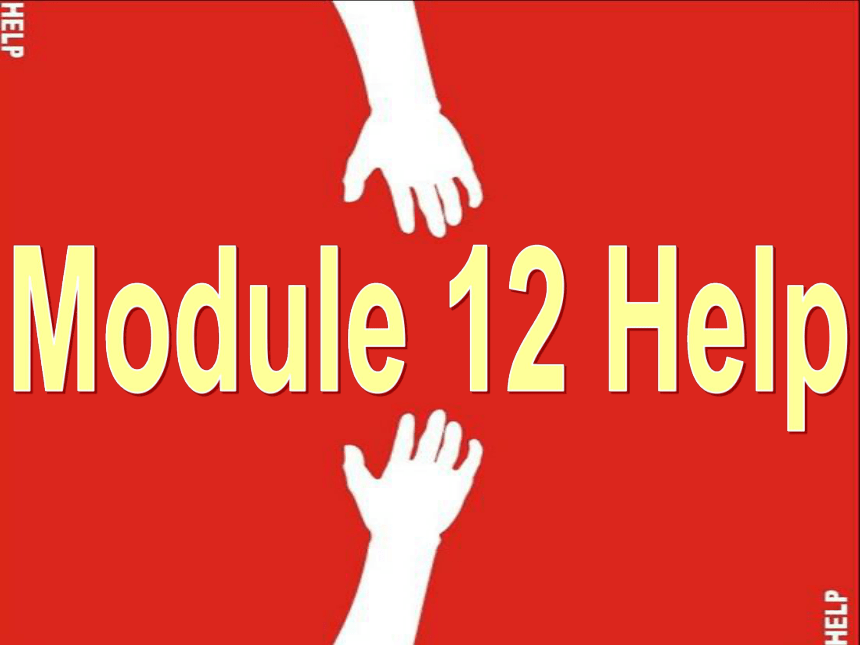
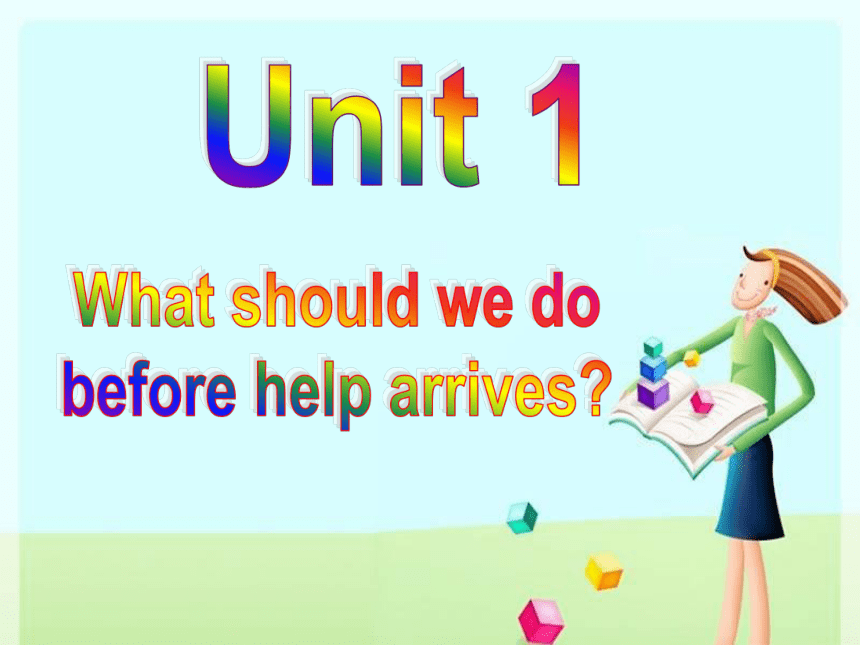


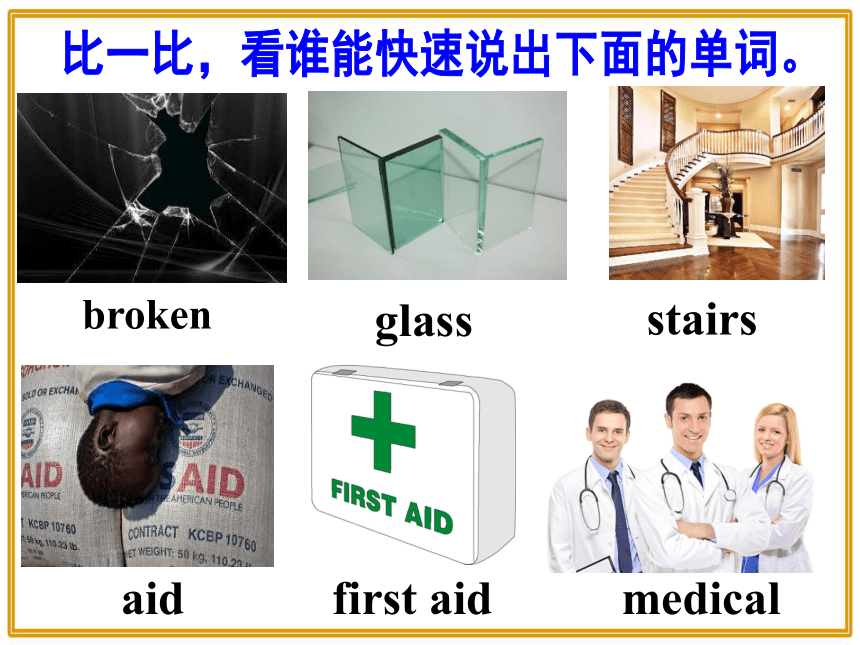
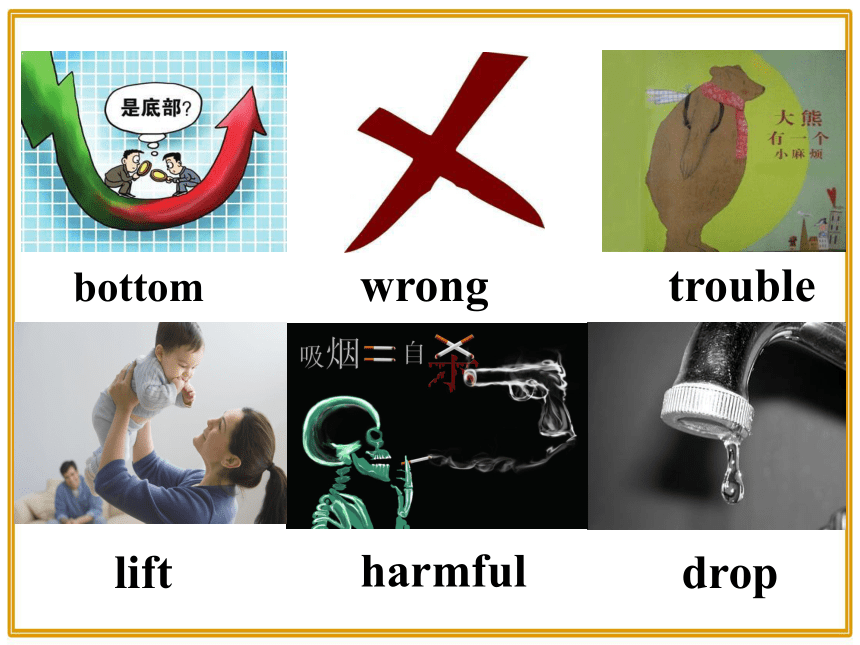

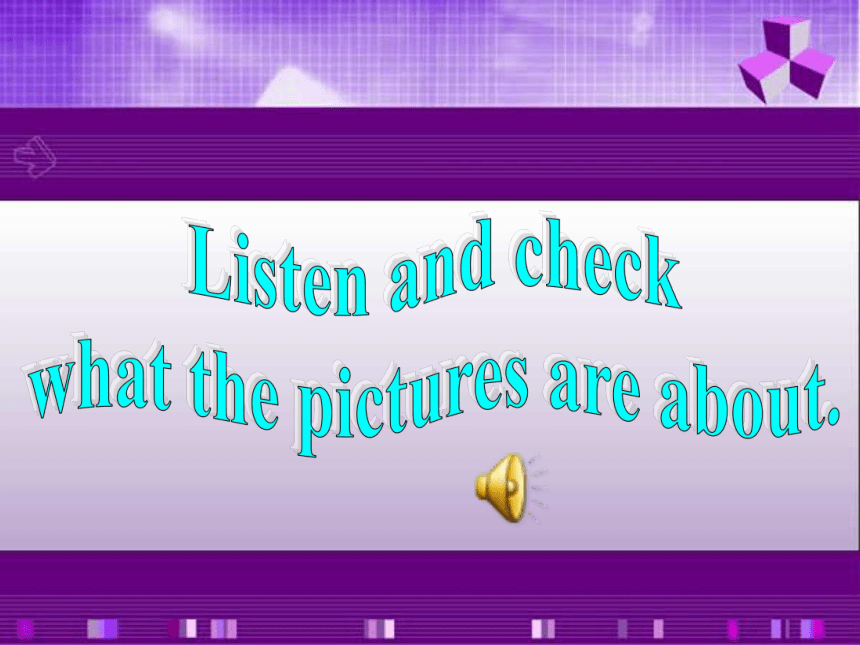
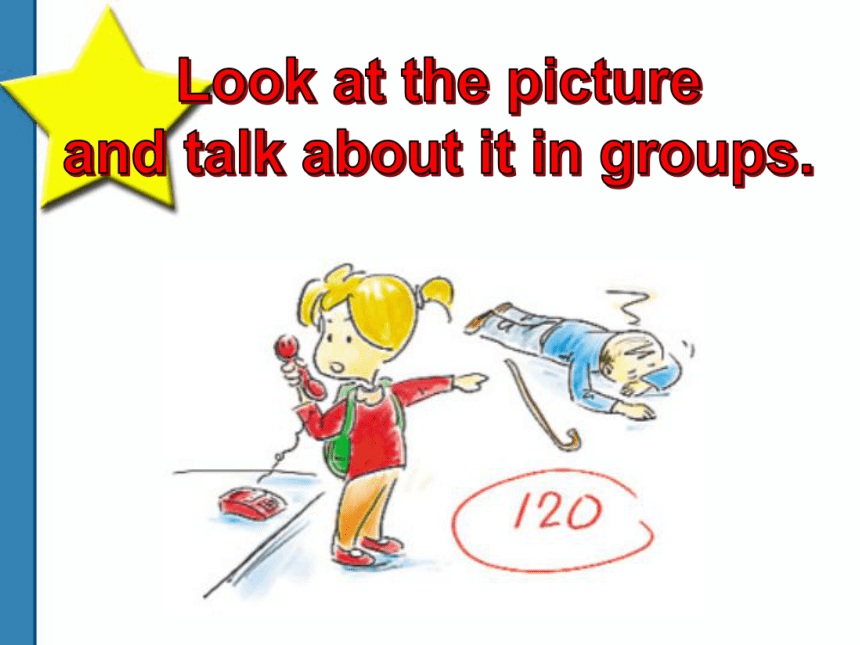

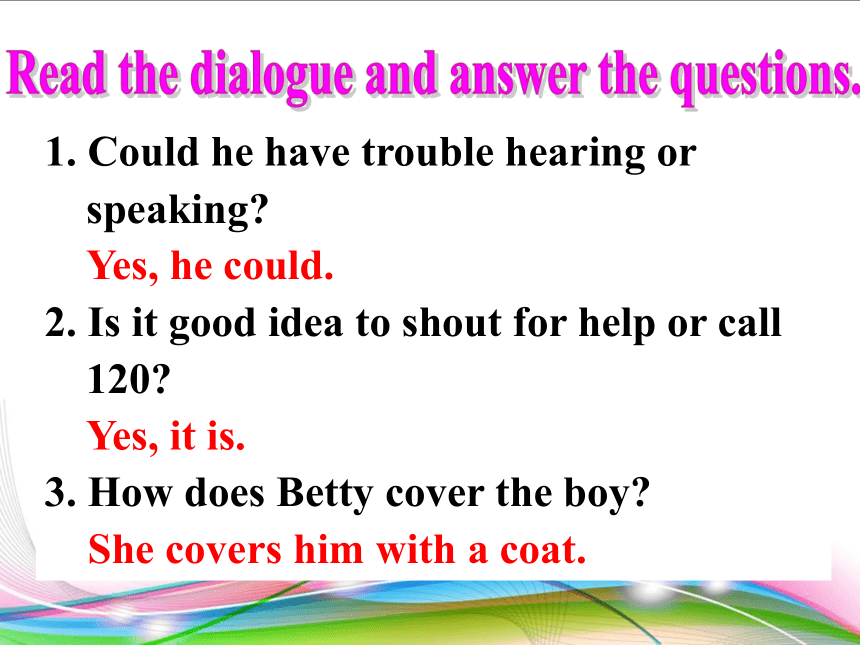
文档简介
课件40张PPT。Module 12Module 12 HelpUnit 1What should we do
before help arrives?We can _______ for help.shoutLead-inLook at the pictures and fill in
what we can do when we see someone in danger.We can ________ 120 for help.callbrokenglassstairsaidmedical比一比,看谁能快速说出下面的单词。first aidbottomwrongtroubleliftharmfuldrop accident broken dangerous furniture glass kitchen stairsWork in pairs. Talk about the pictures.
Use the words in the box to help you.Listen and check
what the pictures are about.Look at the picture
and talk about it in groups.Listen to the dialogue and answer the questions.1. Where is the boy lying?He is lying at the bottom of the stairs.2. Do they lift him up?No, they don’t.1. Could he have trouble hearing or speaking?
Yes, he could.
2. Is it good idea to shout for help or call 120?
Yes, it is.
3. How does Betty cover the boy?
She covers him with a coat.Read the dialogue and answer the questions.√√××√Now read these first aid suggestions and
decide if they are good ideas(√) or bad ideas(×).Let’s (1)________ you see a boy lying at the (2)_______ of the stairs. What should you do? Call for (3)________ help immediately. Do not (4)____ the boy up and sit him on a chair. This could be (5)________ for him. Complete the passage with the words in the box.imaginebottommedicalliftbottom Cover drop harmful imagine lift medical painharmfulEven worse, you might (6)______ him while you are moving him! That would cause a lot of (7)______. (8)_______ him with a coat and make sure he is warm. Then wait for the doctors to arrive.painCoverdropEveryday English What can we do to …? How do we do that? How can we do that?2. He is in pain.
in pain 的意思是“处在疼痛之中”。
e.g. Are you still in pain? Language points1. A boy is lying at the bottom of the stairs.
at the bottom of 表示“在…...的底部”。
e.g. A village lies at the bottom of the hill.3. First of all, find out what’s wrong with him.
first of all 表示“首先”。
e.g. First of all, let me tell you the news.
find out 通常表示“弄明白,搞清楚,查明......”。
e.g. Did the teacher find out who broke the door? What’s wrong with …? 表示“…...怎么了?”
e.g. -- What’s wrong with the boy?
-- He broke his leg.4. But he could have trouble hearing you
or speaking to you.
句中的could表示推测。
e.g. You could be right. have trouble doing sth. 的意思是“做…...有困难”。
e.g. Maria has trouble finding a job and is still staying at home. 5. Lift him up and sit him on a chair?
lift up 表示“抬起,提起”。要把代词放在中间。
e.g. We’ll have to lift up the car to get her out.6. Make sure he’s warm.
make sure 的意思是“确保,保证”。
e.g. Make sure you turn off all the lights before you go out.7. That’s such good advice that you could be a doctor, Betty!
such ... that ... 这个句型表达“如此......以至于......”的意思,such后面接名词,名词前可以有形容词修饰。如果只有形容词或副词,则要使用 so ... that ... 这一句型。e.g. It is such a tiny kitchen that only one
person can cook in it.
They are such nice people that we all
like them. He was so weak that he could hardly stand up.
Everything happened so quickly that I hadn’t time to think. 1. Let’s imagine an accident.
2. What can we do to help him?
3. Find out what’s wrong with him.
4. Make sure he’s warm.
5. Cover him with a coat.Listen and underline
the words the speaker stresses.Now listen again and repeat.1. Let’s imagine an accident.
2. What can we do to help him?
3. Find out what’s wrong with him.
4. Make sure he’s warm.
5. Cover him with a coat.Work in pairs. Ask and answer questions.Student A: You are a teacher of basic medical training.
Student B: You are a student of basic medical training.
-- What do you do if someone’s hurt?
-- Ask him/her what happened …祈使句
一、定义:
祈使句表达说话人对对方的叮嘱、劝告、希望、禁止、建议、请求或命令等。
二、祈使句的特征:
以动词原形开头,无时态和数的变化。Grammar三、祈使句的句型:
1. 动词原形构成的祈使句
通常省略主语 you,谓语动词用原形。否定句由 don’t 或 never 开头。祈使句的句首或句末有时加 please。2. let 构成的祈使句
由“Let + me/us/him/her + 动词原形”构成。这类祈使句往往用于请求允许(let us)或提出建议(let’s)。例如:
Let’s spend this weekend in the countryside.
Let him be here by ten o’clock.3. 无动词祈使句
在请求,命令和口号中,常用无动词祈使句,它实际上是省略了动词,从而使语句更简洁有力。例如:
Just a minute, please!
在一些指示牌上,常用“No + 动名词/名词”构成省略的否定祈使句。
例如:No smoking!重点短语、句型
first aid at the bottom of
lift up make sure
What’s wrong with …?
祈使句的用法本课小结 _______ the hill, I found a telephone and called the police.
A. At the bottom of B. At the top
C. On the bottom D. On the top of
2. If you find you are in _____ then you should stop and take a rest.
A. pay B. happy C. happiness D. painA练一练D3. — What’s wrong _______ you?
— I’m feeling bad.
A. on B. with
C. of D. before
4. She will _____ her hand when she knows the answers.
A. lift up B. lift down C. lie up D. lie downBA中 考 链 接1. Don’t ______ up English. It’s very important. 【2012四川南充】
A. give B. hurry C. stay
2. — Oh, we’ve missed the 6 o’clock film.
— ______. It’ll be on again in two hours. 【2012浙江嘉兴】
A. Have fun B. Don’t worry
C. Sounds great D. You’re welcomeAB3. _____ get off the bus before it stops. 【2012湖南永州】
A. Don’t B. Doesn’t C. Didn’tA4. Which is a traffic sign? 【2012江苏徐州】
A. KEEP QUIET B. DO NOT DISTURB
C. TURN LEFT D. SOLD OUT C5. Jack, _______, or you will get heavier. 【2012重庆市】
A. doesn’t play sports any more
B. doesn’t eat so much meat
C. don’t play sports any more
D. don’t eat so much meatD 编写一个关于 first aid 的对话,字数不少于50字。HomeworkThank you!
before help arrives?We can _______ for help.shoutLead-inLook at the pictures and fill in
what we can do when we see someone in danger.We can ________ 120 for help.callbrokenglassstairsaidmedical比一比,看谁能快速说出下面的单词。first aidbottomwrongtroubleliftharmfuldrop accident broken dangerous furniture glass kitchen stairsWork in pairs. Talk about the pictures.
Use the words in the box to help you.Listen and check
what the pictures are about.Look at the picture
and talk about it in groups.Listen to the dialogue and answer the questions.1. Where is the boy lying?He is lying at the bottom of the stairs.2. Do they lift him up?No, they don’t.1. Could he have trouble hearing or speaking?
Yes, he could.
2. Is it good idea to shout for help or call 120?
Yes, it is.
3. How does Betty cover the boy?
She covers him with a coat.Read the dialogue and answer the questions.√√××√Now read these first aid suggestions and
decide if they are good ideas(√) or bad ideas(×).Let’s (1)________ you see a boy lying at the (2)_______ of the stairs. What should you do? Call for (3)________ help immediately. Do not (4)____ the boy up and sit him on a chair. This could be (5)________ for him. Complete the passage with the words in the box.imaginebottommedicalliftbottom Cover drop harmful imagine lift medical painharmfulEven worse, you might (6)______ him while you are moving him! That would cause a lot of (7)______. (8)_______ him with a coat and make sure he is warm. Then wait for the doctors to arrive.painCoverdropEveryday English What can we do to …? How do we do that? How can we do that?2. He is in pain.
in pain 的意思是“处在疼痛之中”。
e.g. Are you still in pain? Language points1. A boy is lying at the bottom of the stairs.
at the bottom of 表示“在…...的底部”。
e.g. A village lies at the bottom of the hill.3. First of all, find out what’s wrong with him.
first of all 表示“首先”。
e.g. First of all, let me tell you the news.
find out 通常表示“弄明白,搞清楚,查明......”。
e.g. Did the teacher find out who broke the door? What’s wrong with …? 表示“…...怎么了?”
e.g. -- What’s wrong with the boy?
-- He broke his leg.4. But he could have trouble hearing you
or speaking to you.
句中的could表示推测。
e.g. You could be right. have trouble doing sth. 的意思是“做…...有困难”。
e.g. Maria has trouble finding a job and is still staying at home. 5. Lift him up and sit him on a chair?
lift up 表示“抬起,提起”。要把代词放在中间。
e.g. We’ll have to lift up the car to get her out.6. Make sure he’s warm.
make sure 的意思是“确保,保证”。
e.g. Make sure you turn off all the lights before you go out.7. That’s such good advice that you could be a doctor, Betty!
such ... that ... 这个句型表达“如此......以至于......”的意思,such后面接名词,名词前可以有形容词修饰。如果只有形容词或副词,则要使用 so ... that ... 这一句型。e.g. It is such a tiny kitchen that only one
person can cook in it.
They are such nice people that we all
like them. He was so weak that he could hardly stand up.
Everything happened so quickly that I hadn’t time to think. 1. Let’s imagine an accident.
2. What can we do to help him?
3. Find out what’s wrong with him.
4. Make sure he’s warm.
5. Cover him with a coat.Listen and underline
the words the speaker stresses.Now listen again and repeat.1. Let’s imagine an accident.
2. What can we do to help him?
3. Find out what’s wrong with him.
4. Make sure he’s warm.
5. Cover him with a coat.Work in pairs. Ask and answer questions.Student A: You are a teacher of basic medical training.
Student B: You are a student of basic medical training.
-- What do you do if someone’s hurt?
-- Ask him/her what happened …祈使句
一、定义:
祈使句表达说话人对对方的叮嘱、劝告、希望、禁止、建议、请求或命令等。
二、祈使句的特征:
以动词原形开头,无时态和数的变化。Grammar三、祈使句的句型:
1. 动词原形构成的祈使句
通常省略主语 you,谓语动词用原形。否定句由 don’t 或 never 开头。祈使句的句首或句末有时加 please。2. let 构成的祈使句
由“Let + me/us/him/her + 动词原形”构成。这类祈使句往往用于请求允许(let us)或提出建议(let’s)。例如:
Let’s spend this weekend in the countryside.
Let him be here by ten o’clock.3. 无动词祈使句
在请求,命令和口号中,常用无动词祈使句,它实际上是省略了动词,从而使语句更简洁有力。例如:
Just a minute, please!
在一些指示牌上,常用“No + 动名词/名词”构成省略的否定祈使句。
例如:No smoking!重点短语、句型
first aid at the bottom of
lift up make sure
What’s wrong with …?
祈使句的用法本课小结 _______ the hill, I found a telephone and called the police.
A. At the bottom of B. At the top
C. On the bottom D. On the top of
2. If you find you are in _____ then you should stop and take a rest.
A. pay B. happy C. happiness D. painA练一练D3. — What’s wrong _______ you?
— I’m feeling bad.
A. on B. with
C. of D. before
4. She will _____ her hand when she knows the answers.
A. lift up B. lift down C. lie up D. lie downBA中 考 链 接1. Don’t ______ up English. It’s very important. 【2012四川南充】
A. give B. hurry C. stay
2. — Oh, we’ve missed the 6 o’clock film.
— ______. It’ll be on again in two hours. 【2012浙江嘉兴】
A. Have fun B. Don’t worry
C. Sounds great D. You’re welcomeAB3. _____ get off the bus before it stops. 【2012湖南永州】
A. Don’t B. Doesn’t C. Didn’tA4. Which is a traffic sign? 【2012江苏徐州】
A. KEEP QUIET B. DO NOT DISTURB
C. TURN LEFT D. SOLD OUT C5. Jack, _______, or you will get heavier. 【2012重庆市】
A. doesn’t play sports any more
B. doesn’t eat so much meat
C. don’t play sports any more
D. don’t eat so much meatD 编写一个关于 first aid 的对话,字数不少于50字。HomeworkThank you!
同课章节目录
- Module 1 How to learn English
- Unit 1 Let's try to speak English as much as possi
- Unit 2 You should smile at her.
- Unit 3 Language in use .
- Module 2 My home town and my country
- Unit 1 It's taller than many other buildings.
- Unit 2 Cambridge is a beautiful city in the east o
- Unit 3 Language in use .
- Module 3 Sports.
- Unit 1 Nothing is more exciting than playing tenni
- Unit 2 This year we training more carefully.
- Unit 3 Language in use .
- Module 4 Planes, ships and trains .
- Unit 1 He lives the farthest from school.
- Unit 2 What is the best way to travel.
- Unit 3 Language in use .
- Module 5 Lao She Teahouse.
- Unit 1 I wanted to see the Beijing Opera.
- Unit 2 It descibes the changes in Chinese society.
- Unit 3 Language in use .
- Module 6 Animals in danger.
- Unit 1 It allows people to get closer to them .
- Unit 2 The WWF is working hard to save them all.
- Unit 3 Language in use .
- Revision module A
- Module 7 A famous story
- Unit 1 Alice was sitting with her sister by the ri
- Unit 2 She was thinking about her cat.
- Unit 3 Language in use .
- Module 8 Accidents
- Unit 1 While the car were changing to red, a car s
- Unit 2 I was trying to pick it up when it bite me
- Unit 3 Language in use .
- Module 9 Population
- Unit 1 The population of China is about 1.37 billi
- Unit 2 Arnwick was a city with 200,000 people.
- Unit 3 Language in use .
- Module 10 The weathe
- Unit 1 It might snow.
- Unit 2 The weather is fine all year round.
- Unit 3 Language in use .
- Module 11 Way of life
- Unit 1 In China ,we open a gift later.
- Unit 2 In England, you usually drink tea with milk
- Unit 3 Language in use .
- Module 12 Help
- Unit 1 What should we do before help arrives?
- Unit 2 Stay away from windows and heavy furniture.
- Unit 3 Language in use .
- Revision module B
